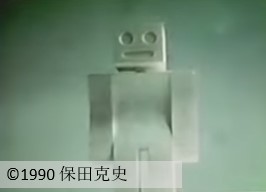90年代アニメーション
I first discovered independent Japanese animation while living in Tokyo in the mid-2000s, and through my research have learnt a lot about current and early independent animation, but I haven’t yet had the opportunity to thoroughly research the animation practices of the 1980s and the 1990s in Japan. So, I was thrilled to discover that JAA members decided to hold a special screening of works form the 1990s at Into Animation 8 earlier this month.
The selection was presented mostly chronologically, with pauses after every few films to introduce the JAA members responsible for the animation. Each animator featured in this program has their own unique individual animation style. Highlights for me included Katsushi BOWDA’s renowned rhythmic stop motion work Pulsar, Yūko ASANO’s brilliant stop motion The Life of Ants, IKIF’s experiment with pixilation, Stop Motion with the ZC1000, Yukio HIRUMA’s mixed media self-reflexive work Magical Product and, of course, the beautiful calligraphy style of Azuru ISSHIKI with her 1992 work Wind. It was such a thrill to meet many animators whose work I had admired for years at Into Animation 8, such as Isshiki and Hal FUKUSHIMA, whose work Manabu’s World screened.
Something very particular to the 80s and 90s were the examples of VIBE IDs: short short animations for station identification that would appear on MTV or other channels after commercial breaks. In effect, they are animated logos for the TV stations. The 3 examples by Keita KUROSAKA are in his signature body horror / gore horror style and must have made a memorable impact on audiences at the time. Kōji YAMAMURA’s were also in a visual style unlike any other animators working in Japan at that time. Tatsuyoshi NOMURA’s well known short shorts from the time were also shown.
The screening closed with the youngest of the filmmakers Saku SAKAMOTO, whose work I first encountered at Nippon Connection in 2008 as part of the Open Art Animation selection. His film The Fisherman (2002) had made an impression on me and it was nice to see another early work by him.
After the screenings, we moved to the workshop room where Tokumine KIFUNE (IKIF), Yukio HIRUMA (Bunka Gakuen University), Tatsuyoshi NOMURA (Robot, Tama Art University), and Katsushi BOWDA (BOWDAS) held a roundtable discussion about animation in the 1990s. This included an overview of the technology that they had at their disposal for making animation, the rapid changes in technology, etc. There was also a discussion about how the JAA played a role in creating events for their works to be screened. The first of the INTO ANIMATION events was held in the 1990s and began to be held every couple of years up until the COVID-19 pandemic interrupted the cycle. The event was moderated by Jun MIYAMORI (宮森潤), who had put together a terrific Excel timeline that he shared with us on screen.
Screened works:
パルサー / Parusā / 3’10”
dir. Katsushi BOWDA / 保田克史
風 / Kaze / 3’40”
dir. Azuru ISSHIKI / 一色 あづる
ストレイシープシリーズ (3本 )
- Stray Sheep: Submarine (1994)
- Stray Sheep: Bath (1995)
- Stray Sheep: Merry-go-round (1995)
Midnight Restaurant (1994)
ミッドナイトレストラン
2’00”
dir. Tatsuyoshi NOMURA / 野村 辰寿
Manabu’s World (1991)
マナブ君の世界 / Manabu-kun no Seikai / 2’03”
dir. Hal FUKUSHIMA / 福島 治
マジックロール・プロダクト / 6’12”
dir. Yukio HIRUMA / 昼間 行雄
Kipling, Jr. (1995)
キップリングJr. / Kippulingu Jr. / 14’00”
dir. Kōji YAMAMURA / 山村 浩二
ATAMA (MTV Japan, 1994)
Flying Daddy (MTV Japan, 1997) / パパが飛んだ朝 / Papa ga Tonda Asa
DRAGON (Vibe pics, 1999)
1’40”
dir. Keita KUROSAKA 黒坂 圭太
VIBE-ID (1999)
2’24”
dir. Kōji YAMAMURA / 山村 浩二
浅野優子『蟻の生活』(1994)【excerpt】 from KRAUT FILM on Vimeo.
Note: you need to be logged into Vimeo to see the above excerpt.
The Life of Ants (1994)
蟻の生活 / Ari no Seikatsu
14’09”
dir. Yūko ASANO / 浅野優子
ZC1000で コマ撮りした (短���版) / ZC1000 de komadorishita (Tanshukuban) / 10’00”
dir. IKIF (animation duo Tokumine KIFUNE 木船徳光 and Sonoko ISHIDA 石田園子)
http://www.ikifplus.co.jp/ikif/
Kai dōryoku REAL (1998)
快動力 REAL / 6’00”
dir. Katsuyoshi BOWDA 保田克史
Maka fushigi (2000)
摩訶不思議 / 10’26”
dir. Saku SAKAMOTO 坂本サク
©2023 Cathy Munroe Hotes

















